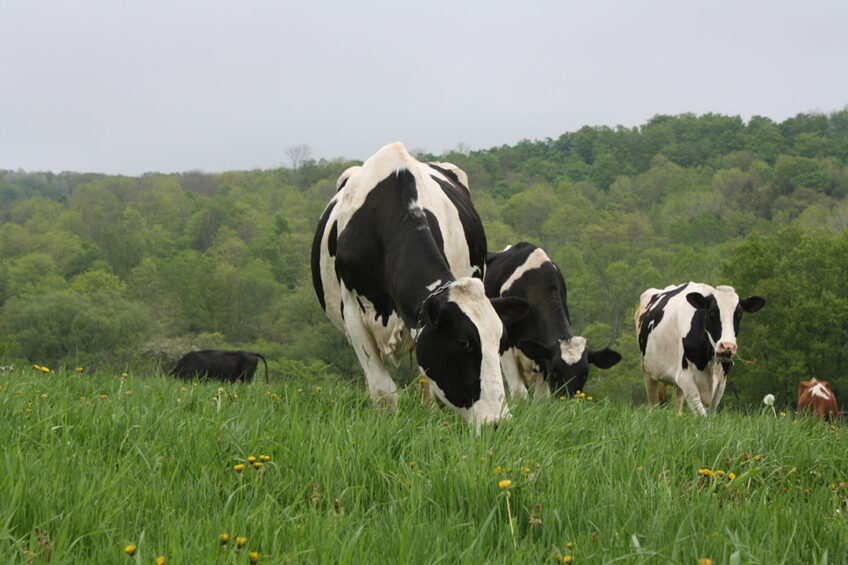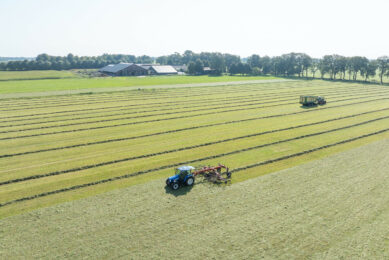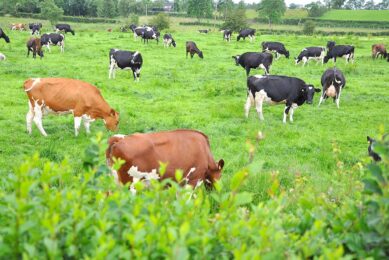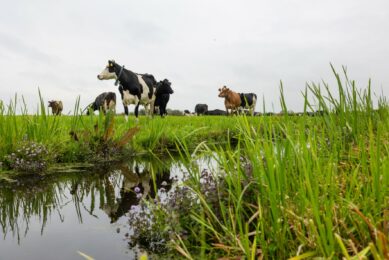Strategies in successful transition to pasture

There are many dairy farmers who would like to transition their entire herd, or just their heifers, to pasture and need practical guidance on how to do it. To help, we have gathered thoughts on best practices from experts in several parts of the globe.
We look at strategies from experts in Europe, several areas of the USA and New Zealand on how to supplement grass feeding so that milk yield stays on target.
Cows have been shown in research trials to be highly motivated to access pasture and to also express more natural behaviours on pasture or on alternative exterior bedding areas. In surveys, consumers also want to see dairy cows enjoying the outdoors.

Cows to pasture ratio
Some farmers would like to transition to pasture for the betterment of their cows and their farm business bottom line – or transition back to pasture after changing it over years ago to field crops and confining their herd – if they have the land for it. The general rule is 1 ac/heifer and 1.25-1.5 ac/milking cow.
Transitioning to pasture has its challenges
For farmers who wish to transition, the first thing to understand is that “the process is not straightforward,” notes Dr Andre Brito, an associate professor in the department of Agriculture, Nutrition, and Food Systems at the University of New Hampshire, USA. For example, the cows will need to get used to this feeding system and there may be some that will never adapt. For the farmer, Dr Brad Heins (associate professor in the Department of Animal Science at University of Minnesota, USA) notes that transitioning to pasture, or any other management system, comes with a fear of the unknown. It’s indeed a big step to move to a new system that could cause milk production to drop and/or may require an unmanageable level of labour.
In the transition period, you will also have to do some culling of animals that do not adapt.”
Economic benefits of transitioning to pasture
However, some farmers are taking the plunge as there is obviously much to be gained from pasture use. Cost of feed can be cut by up to more than half, and there are also costs of reduced cleaning of the barn. And whilst Heins notes that there has not been a lot of economic analysis in Minnesota comparing profits of pasture versus field crops, “most of the data shows a pasture system is more profitable to the dairy farmer than cropping the land,” he explains. “You only need to plant it once every 5 years or longer. Some of our university pastures are at least 20 years old.”
 How pasture access impacts cow welfare
How pasture access impacts cow welfare
Access to pasture or an alternative outdoor area is important – and scientists from Canada note that this can be an aspect of welfare that may be overlooked.
Break-even point of the transition to pasture
Of course, Dr Heins adds that farmers of grazing herds do need to have fencing and move that fencing, and have waterlines. He says most farmers have water lines going to the pasture so that the cows don’t have to waste energy walking to a water source. The break-even point, or ROI for savings of grazing to pay for the costs of buying and installing fencing and waterlines can be reached in 2 or 3 years, he notes, but it’s less if a farmer can access a cost-sharing programme. “We have it here in Minnesota and with this funding, you can break even in about a year,” Heins explains. “You need to have a close look at your total costs of having a confined versus a grazing herd, accounting for all labour.” Waterlines, for example, need to be drained before winter.
Dr Kathy Soder, scientist at the US Department of Agriculture-Agriculture Research Service (Pasture Systems and Watershed Management Research Unit) in Pennsylvania, notes that in comparing costs of pasture-based and confined herds, farmers need to closely look at the overall business models. “The thing to keep in mind with confined herds, you are pushing milk production to its highest and have high feed costs, including growing it or buying, handling it and cleaning out the barn,” she explains. “With grazing herds, farmers aren’t pushing hard for milk production. Your overhead costs are lower, your feed costs are so much lower, and so you can afford your milk production to be lower. Yes, if you get hail or drought, that’s a worry and you do have to be an excellent pasture manager.”
Your grass has to be top quality, but it’s a moving target. By the time you get your results back, the cows have moved on…”
Herd genetics and grass quality
Before we get into how to supplement properly and other best practices, we should touch on genetics. Cows that are grazed generally have moderate-sized frames and must have sound legs for all the walking. Milk production is considered moderate. In Pennsylvania, Soder says pasture-based herds have a lot of Holstein-Jersey crosses with perhaps some European genetics from herds on pasture-based systems there. “For your long-term herd genetics plan during the transition from a confinement to a grazing herd,” she says, “you can either buy some heifers or mature cows that have been raised on a grazing farm, or breed differently. In the transition period, you will also have to do some culling of animals that do not adapt.”
 Maximise use of grazed grass for cost effective milk production
Maximise use of grazed grass for cost effective milk production
Dairy farmers now, more than ever, must ensure they maximise the use of every square inch of grazed grass to help produce milk at a lower cost.
Concerning grass quality, Brito notes that it can certainly differ. Adding legumes (alfalfa or white/red clover) to pasture mixtures provides nitrogen fixing and also boosts milk production. For her part, Soder is among those who strongly favour forage testing. “It’s extremely important,” she says. “Your grass has to be top quality, but it’s a moving target. By the time you get your results back, the cows have moved on, but it does give you a baseline and you should at least do tests in the spring, summer and fall when the pasture undergoes its major yearly changes.”
Cows have to learn how to graze and it can take a generation…”
Transitioning to pasture – steps and best practices
![]() Farmers must fully understand how to master rotational grazing.
Farmers must fully understand how to master rotational grazing.
![]() They must also have a plan in place for supplementing energy. “If the cows are being offered a new fresh pasture at the correct rate with rotational grazing, protein is not a problem, but energy will be,” says Brito. “They will need to be supplemented with energy sources like molasses and even sucrose, or some corn- or barley-based grains. Many cows in New Hampshire and beyond are producing decent amounts of milk only on pasture or on pasture supplemented with molasses. Farmers also feed corn silage or TMR in addition to grazing cows. There are a lot of options.” He notes that if you want to reduce grain costs, keep the quality of the forage high.”
They must also have a plan in place for supplementing energy. “If the cows are being offered a new fresh pasture at the correct rate with rotational grazing, protein is not a problem, but energy will be,” says Brito. “They will need to be supplemented with energy sources like molasses and even sucrose, or some corn- or barley-based grains. Many cows in New Hampshire and beyond are producing decent amounts of milk only on pasture or on pasture supplemented with molasses. Farmers also feed corn silage or TMR in addition to grazing cows. There are a lot of options.” He notes that if you want to reduce grain costs, keep the quality of the forage high.”
In New Zealand, a few farmers don’t supplement at all but most supplement about 30% of the diet with winter forages, baleage, haylage or silage, according to Dr. Pablo Gregorini, professor of livestock production as well as director of the International Pastoral Livestock Production LAB and Center of Excellence, Future Productive Landscapes at Lincoln University in Canterbury. “Almost all dairy cows are on pasture here, and all cows calve from mid-July to mid-August, so supplementation occurs in the fall to extend lactation,” he explains. “Our cows are smaller and produce about 25 litres of milk a day.”
![]() Consider trying heifers first. “Cows have to learn how to graze and it can take a generation,” says Soder. “Heifers that grow up with it is a good place to start.”
Consider trying heifers first. “Cows have to learn how to graze and it can take a generation,” says Soder. “Heifers that grow up with it is a good place to start.”
![]() Transition slowly. Watch milk production closely, and if it dips, supplement with more energy. “Typically, we recommend slowing cutting down on 1:1 silage to grass on a dry matter basis,” says Soder. “A pound of energy decreases pasture intake by half a pound but net dry matter intake and energy intake is going to be higher. So, you don’t have to do as much energy supplementation as you may think.”
Transition slowly. Watch milk production closely, and if it dips, supplement with more energy. “Typically, we recommend slowing cutting down on 1:1 silage to grass on a dry matter basis,” says Soder. “A pound of energy decreases pasture intake by half a pound but net dry matter intake and energy intake is going to be higher. So, you don’t have to do as much energy supplementation as you may think.”
![]() Watch the weather’s effect on pasture growth and also feeding behaviour.
Watch the weather’s effect on pasture growth and also feeding behaviour.
Dr Heins notes that based on research and extension work, farmers in Minnesota on average supplement 50% of the dry matter of the ration with haylage or corn silage, depending on the weather. “We’re doing this right now (start of July) with our study herd as pasture growth has slowed down due to not a lot of rain,” he says. “Also, the cows just don’t eat as much in the hot weather. We can supplement from 30% to 100% throughout the summer, depending.”
Seeing is believing
Brito’s parting advice? “In your pasture, fertilise, do forage analysis and always rotate correctly to make sure vegetative high-quality, highly-digestible forage is available to your cows,” he says. “Success with grazing is directly tied to your abilities in mastering pasture management.”
Dr Heins stresses that farmers will never know if grazing will be a success until they try it. “I think they just need to take that leap of faith and see how it works,” he says. “Seeing is believing.”










